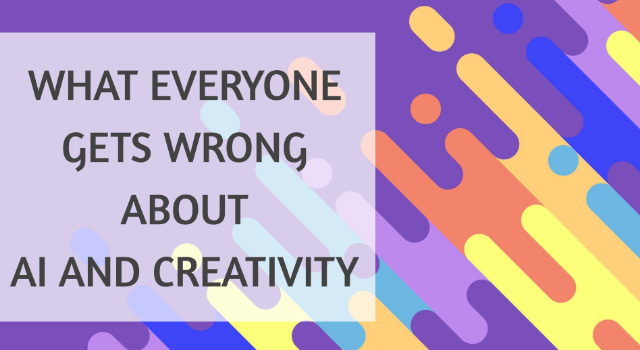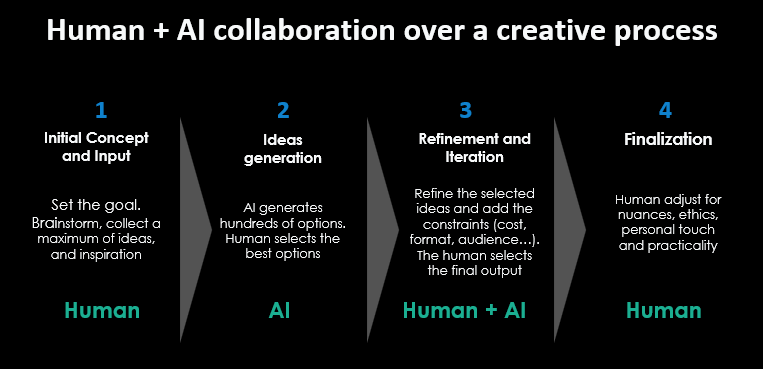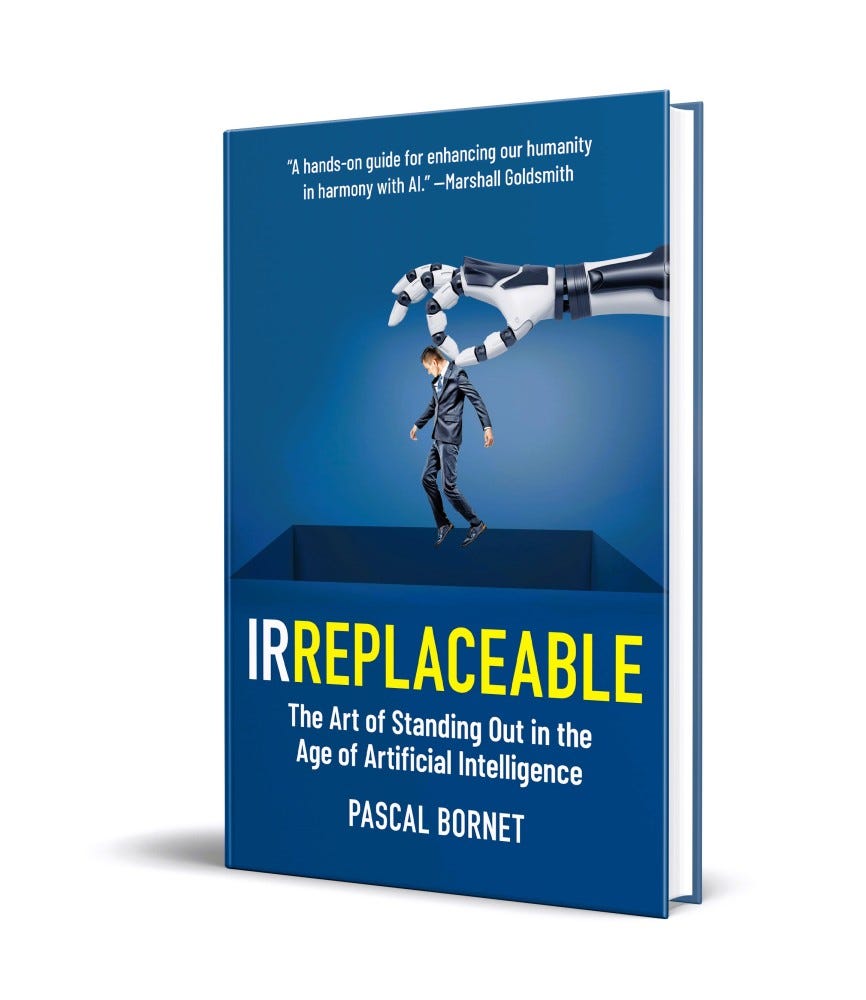What Everyone Gets Wrong About AI and Creativity
This is an abstract from the book IRREPLACEABLE. Please like, comment, and share if you appreciate the insight. This is the outcome of years of research at the intersection AI-Human. Thanks, Pascal
As explained in the book IRREPLACEABLE, in an era of AI, the specificities of human creativity become one of our key advantages: a way to differentiate ourselves from AI and a way to generate more value with it. As creativity emerges as one of the most crucial skills of the future, we need to learn how to develop it to the highest extent. How do we do that? I had the pleasure to sit down with Drew Boyd, one of the world's foremost experts in creativity and innovation, who serves as a professor at the University of Cincinnati and has spent over 40 years working in marketing and teaching creative thinking. Our conversation revealed powerful insights about elevating our creative abilities to generate more value with AI.
Understanding True Human Creativity
Creativity extends far beyond artistic expression—it's our ability to generate novel and original ideas, solutions, or expressions that emerge from the depths of our consciousness, emotional intelligence, and lived experiences. Unlike AI, which excels at combining existing data in new ways, human creativity draws from a profound well of personal experience and emotional understanding that machines cannot replicate. Our creative process involves not just combining elements, but comprehending their emotional resonance, cultural significance, and human impact. This makes our creative output as unique as our fingerprints, intimately connected to our life stories, personalities, and even our fears and hopes.
The Growing Importance of Human Creativity in the Age of AI
As AI systems become more sophisticated at processing and generating content, the market increasingly recognizes the unique value of human creativity. This isn't just theoretical—it's reflected in tangible market trends, with roles requiring high creative skills seeing remarkable growth. Creative director positions, for instance, have experienced salary increases of up to 94% over the last 7 years. This dramatic rise reflects a fundamental truth: while AI can generate variations and process vast amounts of data, it cannot replicate the depth of human creativity that comes from our lived experiences and emotional understanding.
Hence the importance of knowing how to cultivate our uniquely human creativity, and how to collaborate with AI to generate superhuman creativity.
A Framework for Human-AI Creative Collaboration
No educational system has yet taught us how to effectively collaborate with AI for creative purposes, making it crucial to understand and implement a structured approach.
Many people unknowingly limit their creative potential by misunderstanding how to collaborate with AI effectively. Common pitfalls include accepting AI's initial outputs without iteration, jumping to implement the first idea that seems viable, or failing to provide sufficient context and guidance to the AI system. Even more concerning, some rely entirely on AI-generated content without adding human insight and refinement—what I call “AI Obesity”.
Through my research and practical experience, I've developed a framework for maximizing creative output through human-AI collaboration. This process consists of four integrated stages that leverage the strengths of both human creativity and artificial intelligence:
Stage 1: Human Foundation Setting
The first stage begins with human input, where we set the creative direction and establish initial parameters. This is where our unique human ability to understand context, emotion, and purpose comes into play. We define the goals, gather inspiration, and create the foundational concept that will guide the entire process. Most importantly, we collect and prepare all relevant information, documents, and reference materials that will help AI understand the context and requirements of our creative endeavor. The quality and completeness of this preparation directly impacts the AI's ability to generate relevant and innovative options.
Stage 2: AI Processing and Generation
In this stage, we feed our collected information to AI systems, which process and analyze the materials to generate multiple creative possibilities. The AI can rapidly produce hundreds of variations and alternatives based on our initial input, drawing connections and patterns that might not be immediately apparent to human observers. The key here is to allow the AI sufficient scope to explore possibilities while ensuring it remains within the parameters established in stage one. During this stage, human curation becomes critical—we select the most promising directions based on our understanding of what will resonate with other humans.
Stage 3: Human-AI Synergy and Refinement
The third stage represents true human-AI synergy, where we work together to refine and iterate on the selected ideas. We add constraints, test variations, and gradually shape the output toward our desired outcome. During this stage, we might ask AI to generate additional variations based on our selected directions or to combine elements from different concepts. The iterative nature of this stage allows us to explore promising directions more deeply while maintaining the human touch that makes the output meaningful.
Stage 4: Human Finalization
The final stage returns to human dominance, where we apply our judgment to ensure the output aligns with ethical considerations, practical requirements, and emotional resonance. This is where our human touch adds the authenticity that makes the final product truly meaningful. We consider factors that AI cannot fully grasp: cultural nuances, emotional impact, and long-term implications.
Developing Creative Capabilities
Through my research and personal experience, I've identified several effective practices for enhancing creativity. Physical exercise, particularly activities like jogging that maintain an elevated heart rate for more than 15 minutes, can significantly boost creative thinking. This works through multiple mechanisms: increased blood flow to the brain, endorphin release, and the opportunity for mind wandering.
I've also discovered that creativity flourishes in the hypnagogic state—that transitional period between wakefulness and sleep. During this state, our subconscious mind becomes more accessible, and we often make unique connections that lead to creative breakthroughs. I keep a journal by my bedside to capture these insights when they arise.
Another powerful technique is achieving a flow state through immersive activities. When writing or working on creative projects, I often combine this with inspiring music to enter a state of heightened focus and creativity. This state creates an optimal balance of neurochemicals that enhance our creative capabilities.
Understanding Systematic Creative Thinking
During our conversation, Drew introduced me to the powerful approach called Systematic Inventive Thinking (SIT). He demonstrated its effectiveness with a simple yet revealing exercise that transformed my understanding of structured creativity.
Using a common pen as an example, Drew guided me through one of SIT's patterns—subtraction. He asked me to mentally disassemble the pen and remove its lower housing, which initially seemed counterintuitive. However, this constraint led to fascinating possibilities: the pen could be integrated into other tools, used in tight spaces, or incorporated into automated systems. This simple exercise demonstrated how structured thinking patterns can lead to innovative solutions we might never have considered through conventional brainstorming.
The SIT method includes five specific patterns for generating creative solutions:
Subtraction: As in the pen example, removing core elements often reveals unexpected opportunities. Drew shared how this pattern has led to innovations across industries, from minimalist product designs to streamlined services.
Task Unification: Making components perform additional functions. Drew pointed out the example of car rear windows that both defrost and serve as radio antennas, demonstrating how single components can serve multiple purposes efficiently.
Multiplication: Creating variations of existing elements while changing their properties. This pattern helps explore modifications that could add value or serve different user needs.
Division: Separating and rearranging components in novel ways. This pattern often reveals new possibilities by questioning traditional component arrangements.
Attribute Dependency: Creating meaningful relationships between variables, like sunglasses that darken in response to light intensity. This pattern helps identify valuable connections between product or service characteristics.
Looking Forward: The Future of Human-AI Creative Collaboration
As Drew reminded me during our conversation, the goal isn't to replace human creativity with artificial intelligence but to create a symbiotic relationship where each enhances the other. Through this partnership, we can push the boundaries of what's possible and create solutions that are both innovative and meaningfully human.
The key is maintaining a practice of creative development while learning to work effectively with AI tools. By combining structured creative thinking methods with AI's computational capabilities, we can achieve outcomes that neither humans nor machines could produce alone. This synthesis represents the future of creativity—one where human insight and artificial intelligence work together to push the boundaries of innovation.
Our creative potential is limitless when we learn to harness both our innate human creativity and AI's capabilities. The future belongs to those who can master this symbiotic relationship, using their developed creative abilities to guide and enhance AI while allowing AI to amplify and expand their creative horizons.
This was an abstract from the book IRREPLACEABLE. Please like and share if you appreciate the insight. This is the outcome of years of research at the intersection AI-Human. Make sure you order your copy.
Thanks, Pascal
#ai #artificialintelligence #futureofwork #skillsofthefuture #tech





